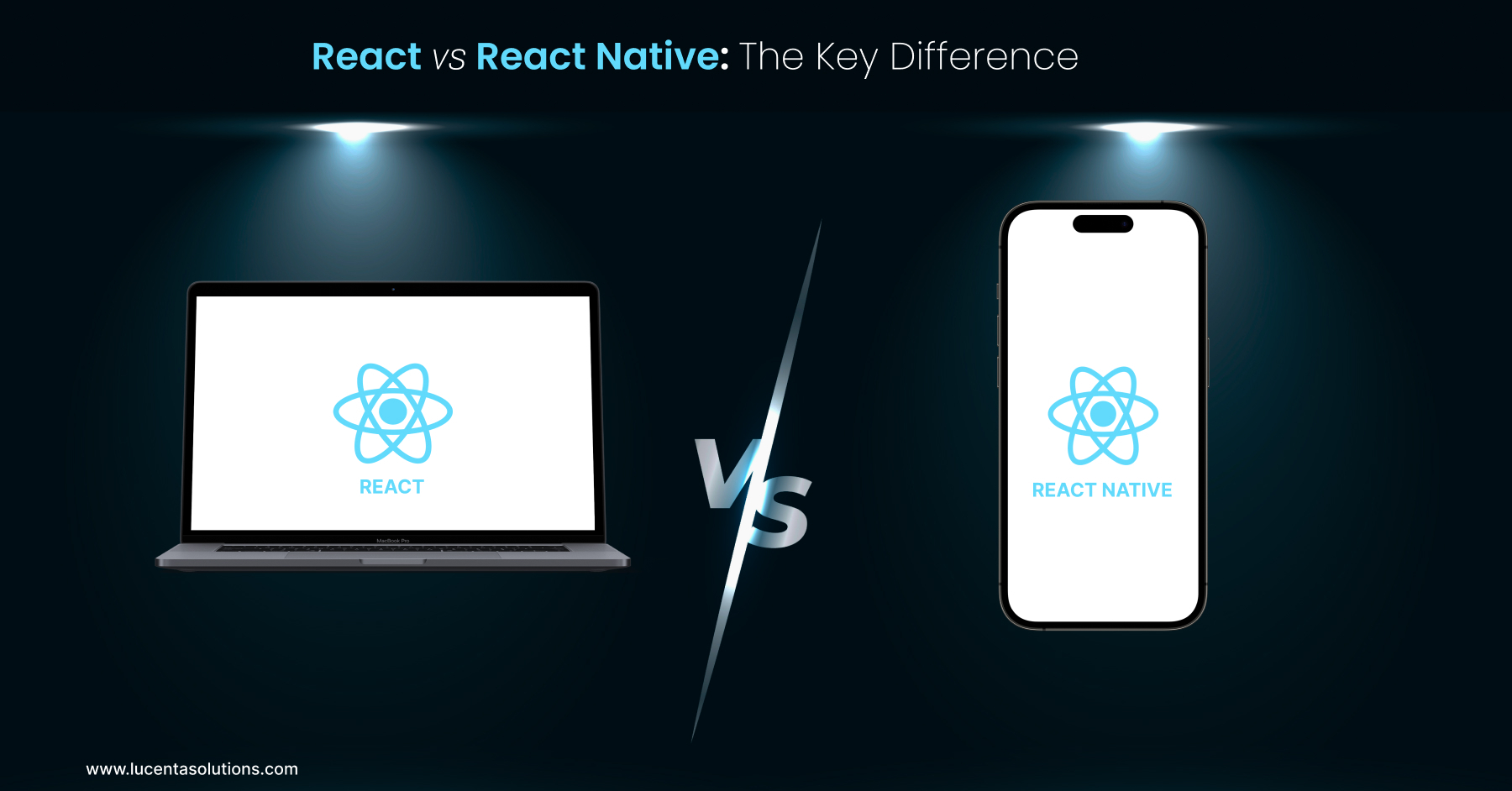React vs React Native: Understanding The Key Difference
Are you into web and application development but always get confused between React vs React Native? Need help deciding which library to use to build a smooth user interface? We are here to help you out. React Native and React are both important tools for web and application development, but each carries its benefits and features. However, an aspirant developer with no coding knowledge often needs clarification because they have the same name.
If you are keen to learn about React and React Native and what differences both these frameworks carry, keep reading this blog.
Introduction to React vs. React Native
Facebook developed React and React Native and is quite successful among app developers. React is the JavaScript library used to create single-page web apps and is often known as ReactJs.
React Native is a framework for designing mobile apps that is built on React JS. Furthermore, you can create native mobile applications using reusable components. When it comes to their popularity, 41% of developers use React, and 32% of developers use React Native. Both frameworks carry competitive market sizes, and choosing between them is quite challenging.
What is React?
React, which is developed and maintained by Facebook (Meta), is a JavaScript toolkit developed and maintained by Facebook (now Meta) and helps to create dynamic, intricate single-page apps.
There is a React component for almost every use case, whether you are creating desktop or mobile apps. Since React carries component-based architecture, creating applications with unique elements that you can mix and match as needed is simple. Since every component is exceptional, you may use many instances of the same element on the same page without worrying about them interfering with one another.
The best part of ReactJs or React is that developers can create anything they want without following rigid guidelines by leveraging its features.
It allows ReactJs developers to integrate plugins and libraries with existing code seamlessly. They can also create straightforward, scalable, and quick web apps thanks to it. React’s introduction to front-end programming revived the much-needed server-side logic.
What is React Native?
React Native is a popular framework that allows JavaScript code to be converted into native Android and iOS app code to create native mobile applications. It offers developers a method to develop native, high-quality applications for both the Android and iOS platforms using a single codebase. React Native is not a rival to React.
React Native is a native C framework, but React is a JavaScript library. The fundamental ideas of both frameworks—such as state management—remain the same despite this distinction.
How do React and React Native Work?
While React Native makes use of APIs to render UI components that are reusable across the Android and iOS platforms, Virtual DOM is the main component of React used Virtual.
Virtual DOM for React JS
Document Object Model (DOM) is a vital programming interface representing web documents. One of the reasons to use DOM for React JS is its speed, performance enhancement and better UX features.
Native APIs for React Native
When rendering UI components, React Native uses Objective-C to develop iOS components, native Application Programme Interface (API), and Java APIs to render Android components.
Also, in React Native, ReactJS uses<p> against <text>, while <div> is used in React instead of <view> for React Native.
For React
For React Native
Image source- Adix
Difference Between React and React Native
Since we have covered React Native components, benefits of react/react native, and brief, let us now check the difference between React and React js.
Installation Process
React
Since React is a JavaScript, the developer needs to integrate the React library with the HTML page. To create a react component, you can use Bundler, which is useful while working on big projects. If you utilize Next.Js, the create-react-app command, or the Gatsby framework for your new projects, Webpack might have been set up to bundle with your application already. If you still need to, you will need to make sure that Webpack is set up.
Bundlers create a single, huge file out of all code-enabled files. Other bundlers like Browserify and Rollup are also available.
Image source- Radix
React Native
The installation process in React Native is quite different. You need a programming environment such as Android Studio for Android or Xcode for iOS to create an app utilizing React Native.
However, as a part of the installation, other tools, including Node, the React Native CLI, JSDK Watchman, etc., are essential. Following installation, you can use the React Native CLI to start a new project and run it on your own devices or a mobile emulator. The best thing is that the migration process from react to react native is simple and quick.
Efficiency
React
ReactJs is the ideal library if you want to create a stunning user interface for your app and web development. The ability of ReactJs to run client-side while rendering server-side is one of its many incredible features.
ReactJS gives developers more alternatives to work with when constructing core abstractions, in addition to increasing their efficiency. In summary, it works well for both higher-level items like dropdown menus and lower-level elements like clickable buttons.
React Native
React Native uses an alternative strategy to increase a developer’s productivity. React JS has equivalents for the components you may use in iOS and Android that have a comparable look and feel. React Native’s fundamental building pieces are reusable native components. These parts are directly compiled into native code. React native stands out from other mobile app development frameworks because the app will have the incredible look and speed of a native app.
Feasibility
React
React solves issues with CSS development by fusing HTML and JavaScript technology. Problems like variable/scope isolation and global namespace are efficiently resolved by integrating CSS within React. This method improves code organization and streamlines CSS development for increased productivity.
React Native
You can easily integrate native iOS and Android app components into your existing app code by using React Native. If the hybrid app is developed using Ionic and Cordova frameworks, you may effectively reuse the Ionic-based code in the form of a plugin.
Storage
React
Local storage is the best option for React. Since the information kept in local storage has no expiration date, it is always there, even after the browser window is closed.
React Native
AsyncStorage is the default data storage solution in React Native. This makes it possible for the program to store data locally. Native code on the iOS platform supports AsyncStorage, which stores larger values in separate files and smaller ones in a specified format. Depending on what is available, AsyncStorage on the Android platform uses SQLite or RocksDB.
Navigation
React
When it comes to navigation and creating React JS applications, it is important to be familiar with the react-router library because it allows for click event-based navigation. Now that React Router v5 has been released, use history hook is now a useful component of the framework. The hook helps in retrieving the history instance, which makes it easier to navigate throughout your application.
React Native
React Native does not support react-router. However, the framework has a library called Navigator that manages screen transitions within an application. Furthermore, React Native Navigation is a different package that provides accurate native platform navigation for both iOS and Android. These libraries guarantee fluid and easy-to-use navigation for mobile React Native apps.
Benefits of React and React Native
Since we know the difference between react and react native, it is essential to understand the benefits of both. Let us check the benefits of each.
Advantages of React
1. Good Speed with DOM
One of React’s advantages from a business standpoint is its capacity to create applications and websites with lightning-fast performance by utilizing the Document Object Model, or DOM.
After computing the resulting differences, React builds an in-memory data structure cache, which updates the browser’s displayed DOM fluidly. While only the updated sub-components are rendered, the programmer writes the code as though the complete page is rendered with each change.
2. Saves Time due to Component-Based Architecture
Component-based architecture, made possible by React, ensures that components may be reused and saves a tonne of time. With the help of this component-based architecture, separate components of a broader user interface can be transformed into self-contained, autonomous microsystems.
Therefore, rather than the entire Facebook Ads user interface, just that particular component within the Adset tab will be reused and re-defined if it requires significant changes.
3. Boost SEO
One of the benefits of using React is that it boosts a webpage or app’s SEO and draws in more organic traffic. Material indexing and caching speed up when a Google bot hits a server that has already rendered the material and graphics. In other words, React helps push the overall SEO strategy, which can be beneficial for apps and websites. Additionally, the page load time is reduced if the Google bot indexes the information directly from the server.
Advantages of React Native
1. Platform-Specific Code
Generating platform-specific code is one of the main advantages of utilizing React Native for app and website development. The platform that an application is running on is automatically detected by the React Native framework when you create one. In this manner, it produces appropriate code for the proper platform.
2. Front-end developers can develop apps
React Native makes it easier for front-end developers to swiftly design apps because the majority of their code is written in JavaScript. A front-end developer only has to be familiar with JavaScript, platform APIs, and any platform-specific design patterns in order to understand the technology.
3. Less Development Time
React Native supports the Hot Reloading functionality, which allows developers to reload a mobile application automatically. This saves time and expedites the development process.
4. Multiple Components
Developers can make use of React Native components for app and website-building purposes. From the user interface to iOS-specific and List Views.
Conclusion
The difference between React and React Native depends on the platform for which you wish to create the product. React Native is best for building apps that function on both iOS and Android. However, React is your best option for creating a web application. Once you are aware of the differences between React and React Native, it will also become easy to hire a mobile app development company using any of the frameworks.




